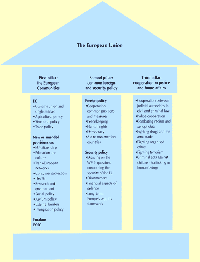An international organization is “a body that promotes voluntary cooperation and coordination between or among its members.”[1] There are many types of international organizations, but one way of categorizing them is to distinguish between intergovernmental organizations and supranational organizations.
The European Union is partly an intergovernmental organization and partly a supranational organization. Both of these elements exist in the European Union.
Check out this diagram explaining how responsibilities used to be divided between the member states (intergovernmental) and the European Community (supranational) before the Lisbon Treaty (2009). The activities of the European Union used to be arranged into three “pillars”. Click on the image to the right to see a diagram of the old Pillar Structure of the EU.
In the first pillar we found most of the supranational elements of the EU. Initially, these mainly involved economic policy, but since have expanded to include aspects of social policy, immigration policy, and education. The first pillar contained aspects of both economic and political integration.
In the second pillar we found some of the intergovernmental elements of the EU. The member states of the EU co-operate to formulate common foreign policy and security policy. In these areas, the members of the European Union retain their authority and autonomy. In other words, if 24 member states agree on a foreign policy, the other member state can choose to pursue its own policy. In this pillar we found aspects of mainly political integration.
The third pillar contained intergovernmental elements for justice and home-affairs, but the Lisbon Treaty has made this policy area supranational instead, calling it the area of freedom, security and justice.
The Lisbon Treaty has collapsed the pillar structure. The European Community (formerly the first pillar) has been abolished, but its powers and institutions remain supranational. These have been transferred to the post-Lisbon EU entity, along with the elements of the former third pillar, which have also become supranational. At the same time, the Treaty keeps the elements of the former second pillar intergovernmental.
In economic and other areas, the EU is supranational and in most other areas, such as the military and foreign policy the EU is intergovernmental. How can we describe the sharing of power between the Member States and the EU?
Intergovernmental Organizations
An intergovernmental organization (IGO) is composed of nation-states and it promotes voluntary co-operation and coordination among its members.[2] Decisions and agreements reached in this type of organization however are not enforceable, and the members remain independent. The crucial aspect of an IGO is that the members do not surrender any power (or sovereignty) to it. The United Nations is an intergovernmental organization.
Supranational Organizations
A supranational organization is different because member states do surrender power in specific areas to the higher organization. Decisions taken by a supranational organization must be obeyed by the member states. Often there are courts to determine when violations have occurred, although frequently enforcement mechanisms are not as effective as they are within nation states.
Is the EU a federation or a confederation?
1. John McCormick. The European Union: Politics and Policies. Westview Press: Boulder Colorado, 1999. p.10.
